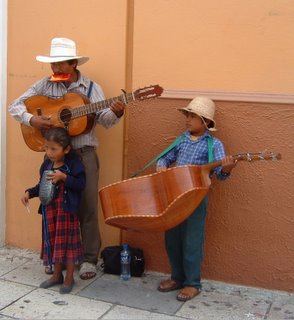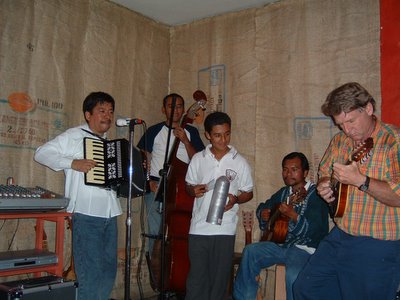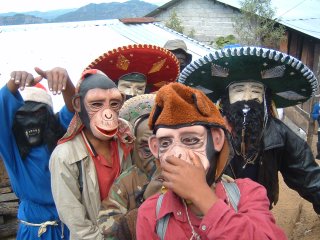 In both cemeteries we visited, we were haunted and comforted by this cycle of rememberance. Each year, the living, from young to old, pay tribute to and remember those who are gone. And when one is gone, one knows that the family gathers to remember. Each human being moves through the circle remembering and being remembered.
In both cemeteries we visited, we were haunted and comforted by this cycle of rememberance. Each year, the living, from young to old, pay tribute to and remember those who are gone. And when one is gone, one knows that the family gathers to remember. Each human being moves through the circle remembering and being remembered. Susan Hegger "Day of the Dead, Night of the Living"
Awed, confused and emotionally warmed....these were some of the many sweet emotions Katy and I lived-out while we observed the 3-4 day rituals known as Dia de los Muertos.
From Oct. 31-Nov. 2, Oaxaquenos ( wah-hah-KAY,knee-os) are very deeply living out the bitter-sweet emotions of remembering deceased loved ones by buying loads of flowers, preparing food, cleaning and decorating gravesides and making small domestic altars. "...Each human moves through the circle..." this profound and simple concept is in motion everywhere in the city during these days. Honor. Cry. Remember. Celebrate. A very mysterious, but obviously a meaningful cultural family story of blending heart and head. Hard to explain, but we felt it all week.
We are alive within mystery. Life is the continual intervention of the inexplicable. We have more than we know. We know more than we can say. The constrictions of language are formed within experience, not the other way around. So finally, we live beyond words, as also we live beyond beyond computation and beyond theory.
Wendell Berry
Some of the shapes and sounds of these rituals have been around for 3,000 yrs. For the last 500 yrs. there has been a blending of Meso-American native people's beliefs with some of the European Catholic traditions brought in by the Spanish in 1519. Some of the known original rituals dealing with the dead were in the the Aztec calendar for July and August. The Spanish Catholics tried to stop the indigineous people from the rituals that they kept so strongly, but when it proved to be tough going, they changed to a more pragmatic course and moved these attitudes/beliefs to fit with the already existing European tradition of All Saints and All Souls Day, Nov. 1-2.
Sort of the same way the European Christian churches incorporated the nativity of Jesus to connect up on the calendar for Dec. 25, with the many European pagan rituals of various harvest/winter solstice festivals. Since there is no date given for the Nativity in the New Testament, and most scholars of Middle East and Christian history agree that Dec. 25 seems unlikely, the early European church missionariessought to to tame and blend some of the local traditions into a celebration of the Son of God.
And so, just like the direct linkeage of Germanic and Scandinavian pagan winter symbols and icons such as trees and fires, to the now softened and blended rituals of Christmas that bring us so much meaning...so too have the images and forms of rituals dealing with skeletons and spirits softened and evolved to give depth and meaning and an opportunity to reflect on the lives and heritage of those passed on ...in this Mexican culture.
Here in Oaxaca, the principal traditions start a 3 pm on Oct. 31 where the spirits of children...called Anglelitos, arrive to visit their families and leave 3 pm Nov. 1 , when the adult spirits visit until 2 pm on Nov. 2 . Spirits of the dead are expected to pay an annual visit home, and so should be provided with enticing favorite foods, momentos, and a few hours of laughter, tears and music before their long journey back. Sort of like leaving cookies and milk for Santa.
Home altars and gravesides have beautiful displays, from simple to grand, of many flowers. Usually marigolds, as this was an Aztec custom to help the spirits back with the fragrance. And there are many items there that represent nature and its uses. You will see things made from water:for thirst, purification...salt: seasoned food,purification...bread: food for survival.
What is so absorbing, is the unique way this cultural ritual has combined and given permission for private pain and grief to also have communal, public expression. Always, always...families are together...sometimes staying in the cemeteries all night. Having a picnic, singing, reflecting. Every year, long after the funeral day, families circle back together. This is a unique, effective way to handle grief and hopefully give closure.
Because here in Mexico there is a dominant tradition of not embalming the body after death. The body is usually laid out on a special table at home for viewing and initial grieving for just 24 hrs....and then walked to the grave. So Dia de los Muertos gives families after the funeral shock, a chance to reunite each year for old stories and old tears....to help complete the circle and form new family stories and new communal tears. Very absorbing concept....Day of the Dead...the past recorded and remembered to give us continuity for the future.
In an old house there is always listening, and more is is heard than spoken.
And what is spoken remains in the room, waiting for the future to hear it.
And whatever happens began in the past, and presses hard on the future.
The agony in a curtained bedroom, whether of birth or dying.
Gathers in to itself all the voices of the past, and projects them into
future.
the treble voices on the lawn
the mowing of hay in summer
the dogs and old pony
and the singing in the kitchen
and the season of stifled sorrow
All twined and tangled together,
all are recorded.
T.S.Eliot from the " Family Reunion"














